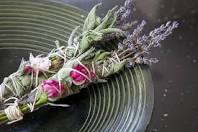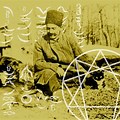Smudge Sticks






Smudge Sticks
In the native American spiritual traditions, smudging plays a central role. Smudge sticks are long bundles of fragrant plant material, wound tightly, lit at one end until the material catches fire, then blown out so it continues to smoulder releasing smoke.
The fragrant materials used by native Americans are usually sage, wormwood, cedar or sweetgrass. Occasionally, depending on the location within the USA and Canada, the soft young stems of pine are used - these have pine needles attached and are very pliable.
There is also a plant called prairie lavender which is included in the smudge sticks of certain Nations; although it is not of the same species of lavender known throughout Europe it has somehow acquired the name lavender from early European settlers.
Sage
There are many types of sage, including salvia apiana which can grow very tall and be over one hundred years of age. Another variety often used is salvia columbarne. Sage brush, artemisia tridentata, belongs to the wormwood family, rather than to the sage.
Wormwood
Artemesias belong to the wormwood family although they are sometimes called sage. They bear no resemblance to the sages we know in Europe. In native American culture, artemisia spinescens is sometimes used in smudge sticks.
Cedar
Often, the trees that are called cedar are actually of the juniper family, such as juniperus virginiana all types of cedar needles are also used, including thuja occidentalis.
Sweetgrass
This is sometimes called vanilla grass, and is hierochloe odorata, a tall green grass which becomes yellowish when dried. On drying, its aroma becomes more apparent. In some nations it is put on the hot stones of sweat lodges.
In all the above, it is the leaves and soft stalks that are used. Smudge sticks are held in the hand, carrying smoke to where it's required, or the smoke is directed by the hands or with a feather.
Other cultures use a small branch of a plant or tree to direct the smoke, often of the same species as that used in the smouldering fragrant material.
You could also use big crystals to spread the smoke around, or other stones that you are attuned to - or amber, which is a resin from a plant.
Reference: The Fragrant heavens: Valerie Ann Worwood
Articles-Latest
- Koran burning conviction sparks fury as blasphemy law 'returns to UK'
- Robert Francis Prevost - Pope Leo XIV
- Pope Francis' death follows recent health challenges. Here's what we know about how he died.
- Easter April 2025 - international Celebrations
- The Rule of the twelve psalms -Worthy is the Lamb
- Religion in Africa Before Christianity and Islam
- 6 The Origin of Yahweh
- Dumo Di Milano
- What Did the Crow Tribe Believe In: Discover The Beliefs!
- 7 Reasons Historic Christianity Rejects the Book of Enoch
- 8 Breathtaking Mountain Monasteries Around the World
- Ethiopian Bible is oldest and most complete on earth
- Muhammad Muhammad was a prophet and founder of Islam.
- World Day of the Poor – SVP Christmas Campaign 2024
- Pope Francis to open 5 sacred portals on Christmas Eve — for a ritual that’s never been done before
- The 144,000 in Revelation
- Over 73 dead bodies 'used for meditation', 600 crocs in a pond, found in two Thai temples
- Occultism: Western Occult Tradition
- What is a Mudra
- Blood Sacrifices: Ancient Rituals of Life and Death
Articles-Most Read
- Home
- Let There Be Light
- Plants that feel and Speak
- The Singing Forest
- The Singing Forest-2
- Introduction
- Meditation
- Using Essential Oils for Spiritual Connection
- Heaven Scent
- Plants that Feel and Speak-2
- Purification
- Making the Spiritual Connection
- Anointing
- Essential Oils: The unseen Energies
- The Sanctity of Plants
- The Aroma Of Worship - Introduction
- The Aroma Of Worship-Foreward
- Methods Of Use
- Spiritual Blending
- Handling and Storage







